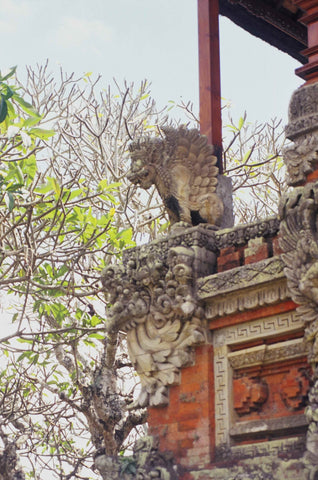The mythical winged lion of Bali. Singa Bersayap..
Writing this essay as my knowledge is that of a bule (pronounced bou lay, a term used to indicate a white person or an outsider). Everything in Bali is complicated and layered and so my knowledge can never be complete. Please, any Balinese friend reading this if you find errors in my story, send me a message.
Lions do not exist in Asia and yet they are found in almost all cultures from ancient Persia through to China and in South East Asia. The origin of the Balinese representation of the lion can be seen in Chinese representations of the lion, however, the singa in Bali has a special place in their spiritual iconography and is different from all others in that it has wings.
Antique Chinese lion
In Balinese legend, the lion is the king of the forest. It is a protector and overcomes and counterbalances evil. Although the Balinese singa is a lion, there is a relationship with the Barong Ket.
The singa in Bali has Hindu-Buddhist origins. In Hinduism, the lion is an avatar of Vishnu. In Buddhism, the Buddha sits upon the lion as a throne of consistency, strength, and wisdom, in Bali the singa is distinguished by its relationship to the barong.
House temple Singa Bersayap. H 32 x L 28 x W 17. Old--possibly 50 to 80 years
The singa above is typical of the traditional Balinese singa. It has a ferocious expression, bulging eyes and fierce fangs. It has wings and a flaming mane. The wings may be a result of blending with the mythical Vishnu Garuda or perhaps the barong which also bears a similarity to the Chinese dragon.
In Bali you can see singa in many places. Often a temple kul-kul will have one on each corner holding up the roof structure

Singa in the kuk-kul Pura Madya, Batu Bulan
On the road to Singaraja, past Bedugul which is in the kingdom of Tabanan, one passes through a gate with a rampant singa on each side. To one side of this there is a kul-kul with four singa supporting the roof. The kulkul's purpose is to summon the locals in the event of an intrusion by negative forces.
The kul-kul at at the gateway between the kingdom of Tabanan and Buleleng (Singaraja- note the loudspakers facing into Buleleng to summons the villagers in the event of an intrusion.)
When thinking about the singa I started to look at the many that we have collected over the years. It was not a deliberate 'collection' and yet I find that we have quite a few pieces.
These two painted wooden singa are almost a pair. They take the traditional form. Obviously from the same studio, but if you look carefully, not the same hand.
Singa 3 Ht 32cm x 28cm x 17 cm Singa 4 Ht 30cm x 20cm x 15cm
This next Singa is from our collection. It is not at all like the traditional carving. It is very old and is an example of folk art. Still with the bulging eyes but it does no have the l ferocious snarl, rather it seems to be smiling. Between its feet is a smiling frog. This would example would have had a place in a house temple. Veronica loves this creature and he is for our house.
.
Singa 1 Height 30cm x 16cm x 20 cm
Another singa that we have is a stone pedestal for one of the corners of a smallish temple bale, most probably a family temple rather than an important village temple.
This next singa is a small one, carved from a single piece of wood. It sits on Veronicas dressing table and she decorates it with sparkling broaches










